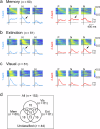Neural correlates of memory updating in the primate prefrontal cortex
- PMID: 40490505
- PMCID: PMC12149290
- DOI: 10.1038/s42003-025-08271-w
Neural correlates of memory updating in the primate prefrontal cortex
Abstract
Working memory allows temporary storage and manipulation of information during cognitive tasks. While the primate lateral prefrontal cortex (PFC) is involved in working memory, little is known about neuronal activity during memory updating. We trained macaque monkeys on an oculomotor n-back task, requiring them to remember locations of sequentially presented visual stimuli and generate a saccade to the location of the most recent or previous stimulus based on task rules. Many PFC neurons showed transient activity when a memory of a particular stimulus location was no longer needed, whereas others showed sustained activity for remembered locations. Decoding analysis successfully predicted future target selection based on the task rule from neuronal activity, indicating that these neuronal populations contain sufficient information to guide behavior. Furthermore, electrical stimulation at recording sites erased specific spatial memories, demonstrating a causal role of prefrontal neurons in maintaining and updating short-term memory.
© 2025. The Author(s).
Conflict of interest statement
Competing interests: The authors declare no competing interests.
Figures





Similar articles
-
Prefrontal task-related activity representing visual cue location or saccade direction in spatial working memory tasks.J Neurophysiol. 2002 Jan;87(1):567-88. doi: 10.1152/jn.00249.2001. J Neurophysiol. 2002. PMID: 11784772
-
Matching patterns of activity in primate prefrontal area 8a and parietal area 7ip neurons during a spatial working memory task.J Neurophysiol. 1998 Jun;79(6):2919-40. doi: 10.1152/jn.1998.79.6.2919. J Neurophysiol. 1998. PMID: 9636098
-
Emergence of Nonlinear Mixed Selectivity in Prefrontal Cortex after Training.J Neurosci. 2021 Sep 1;41(35):7420-7434. doi: 10.1523/JNEUROSCI.2814-20.2021. Epub 2021 Jul 22. J Neurosci. 2021. PMID: 34301827 Free PMC article.
-
Retrospective and prospective information coding by different neurons in the prefrontal cortex.Neuroreport. 2013 Jan 23;24(2):73-8. doi: 10.1097/WNR.0b013e32835c8d66. Neuroreport. 2013. PMID: 23269282
-
Information processes in the primate prefrontal cortex in relation to working memory processes.Rev Neurosci. 2002;13(4):313-45. doi: 10.1515/revneuro.2002.13.4.313. Rev Neurosci. 2002. PMID: 12542260 Review.
References
-
- Goldman-Rakic, P. S. Cellular basis of working memory. Neuron14, 477–485 (1995). - PubMed
-
- Christophel, T. B., Klink, P. C., Spitzer, B., Roelfsema, P. R. & Haynes, J. D. The distributed nature of working memory. Trends Cogn. Sci.21, 111–124 (2017). - PubMed
-
- Courtney, S. M., Ungerleider, L. G., Keil, K. & Haxby, J. V. Transient and sustained activity in a distributed neural system for human working memory. Nature386, 608–611 (1997). - PubMed
-
- Freedman, M. & Oscar-Berman, M. Bilateral frontal lobe disease and selective delayed response deficits in humans. Behav. Neurosci.100, 337–342 (1986). - PubMed
MeSH terms
Grants and funding
LinkOut - more resources
Full Text Sources
Miscellaneous

